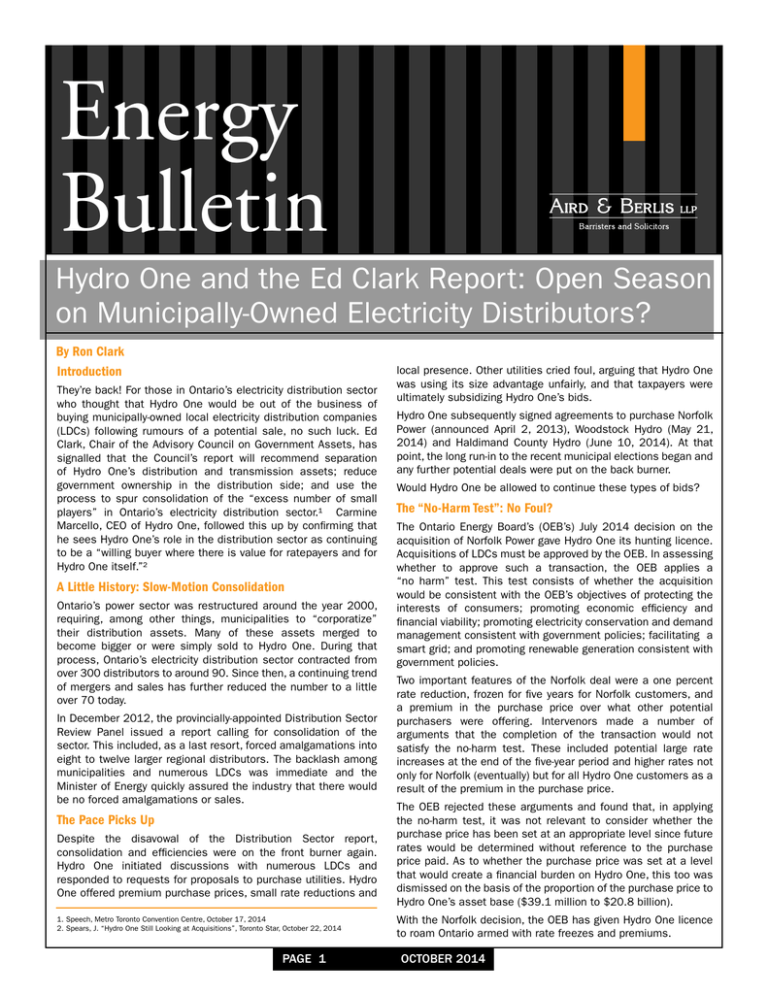Hydro One and the Ed Clark Report: Open Season on Municipally
advertisement

Energy Bulletin Hydro One and the Ed Clark Report: Open Season on Municipally-Owned Electricity Distributors? By Ron Clark Introduction They’re back! For those in Ontario’s electricity distribution sector who thought that Hydro One would be out of the business of buying municipally-owned local electricity distribution companies (LDCs) following rumours of a potential sale, no such luck. Ed Clark, Chair of the Advisory Council on Government Assets, has signalled that the Council’s report will recommend separation of Hydro One’s distribution and transmission assets; reduce government ownership in the distribution side; and use the process to spur consolidation of the “excess number of small players” in Ontario’s electricity distribution sector.¹ Carmine Marcello, CEO of Hydro One, followed this up by confirming that he sees Hydro One’s role in the distribution sector as continuing to be a “willing buyer where there is value for ratepayers and for Hydro One itself.”² A Little History: Slow-Motion Consolidation Ontario’s power sector was restructured around the year 2000, requiring, among other things, municipalities to “corporatize” their distribution assets. Many of these assets merged to become bigger or were simply sold to Hydro One. During that process, Ontario’s electricity distribution sector contracted from over 300 distributors to around 90. Since then, a continuing trend of mergers and sales has further reduced the number to a little over 70 today. In December 2012, the provincially-appointed Distribution Sector Review Panel issued a report calling for consolidation of the sector. This included, as a last resort, forced amalgamations into eight to twelve larger regional distributors. The backlash among municipalities and numerous LDCs was immediate and the Minister of Energy quickly assured the industry that there would be no forced amalgamations or sales. The Pace Picks Up Despite the disavowal of the Distribution Sector report, consolidation and efficiencies were on the front burner again. Hydro One initiated discussions with numerous LDCs and responded to requests for proposals to purchase utilities. Hydro One offered premium purchase prices, small rate reductions and 1. Speech, Metro Toronto Convention Centre, October 17, 2014 2. Spears, J. “Hydro One Still Looking at Acquisitions”, Toronto Star, October 22, 2014 Page 1 local presence. Other utilities cried foul, arguing that Hydro One was using its size advantage unfairly, and that taxpayers were ultimately subsidizing Hydro One’s bids. Hydro One subsequently signed agreements to purchase Norfolk Power (announced April 2, 2013), Woodstock Hydro (May 21, 2014) and Haldimand County Hydro (June 10, 2014). At that point, the long run-in to the recent municipal elections began and any further potential deals were put on the back burner. Would Hydro One be allowed to continue these types of bids? The “No-Harm Test”: No Foul? The Ontario Energy Board’s (OEB’s) July 2014 decision on the acquisition of Norfolk Power gave Hydro One its hunting licence. Acquisitions of LDCs must be approved by the OEB. In assessing whether to approve such a transaction, the OEB applies a “no harm” test. This test consists of whether the acquisition would be consistent with the OEB’s objectives of protecting the interests of consumers; promoting economic efficiency and financial viability; promoting electricity conservation and demand management consistent with government policies; facilitating a smart grid; and promoting renewable generation consistent with government policies. Two important features of the Norfolk deal were a one percent rate reduction, frozen for five years for Norfolk customers, and a premium in the purchase price over what other potential purchasers were offering. Intervenors made a number of arguments that the completion of the transaction would not satisfy the no-harm test. These included potential large rate increases at the end of the five-year period and higher rates not only for Norfolk (eventually) but for all Hydro One customers as a result of the premium in the purchase price. The OEB rejected these arguments and found that, in applying the no-harm test, it was not relevant to consider whether the purchase price has been set at an appropriate level since future rates would be determined without reference to the purchase price paid. As to whether the purchase price was set at a level that would create a financial burden on Hydro One, this too was dismissed on the basis of the proportion of the purchase price to Hydro One’s asset base ($39.1 million to $20.8 billion). With the Norfolk decision, the OEB has given Hydro One licence to roam Ontario armed with rate freezes and premiums. October 2014 ENERGY Bulletin Aird & Berlis LLP Hydro One in Play? In April 2014, the Ed Clark panel was appointed to “consider various options to generate better returns and revenues to maximize the value of” Hydro One (along with the LCBO and Ontario Power Generation). Questions began to be asked about the future of Hydro One and whether it would still be in the acquisition game. Would Hydro One’s attention turn inward, toward restructuring or possible sale? In June, thousands of complaints by Hydro One customers around billing practices were referred to the Ontario ombudsman, which didn’t help the company’s image in wooing potential municipal vendors. In early October 2014, it was reported that the Electricity Distributors Association (EDA), representing the LDCs (including, at that time, Hydro One), was considering a plan to buy Hydro One’s electricity distribution business.³ This plan involved some LDC consolidation as well. In response, Hydro One resigned from the EDA. Back in the Hunt Now, with Ed Clark signalling that the restructuring of Hydro One should be used as a catalyst for continuing consolidation of the distribution sector, the hunt is on again. Carmine Marcello has put the billing issues behind him and has announced his continuing willingness to purchase LDCs. Game On! What does this mean for municipally-owned LDCs? Now that the municipal elections are over, those who were in discussion with Hydro One can likely resume their discussions following the installation of new councils. For those looking to sell, premiums are still available. The LDCs that are competing with Hydro One to acquire or merge with other LDCs will have to offer a value proposition other than premium prices and rate freezes. We have seen effective alternatives to the Hydro One approach. In Collingwood, PowerStream became a 50/50 partner with the Town. In Brant County, a sale to a neighbouring utility was considered desirable. For an LDC that seeks to stay independent, there is no question that the ground will continue to shift under its feet. The desire of many municipalities to retain “their” utilities for reasons of local presence, identity, control, independence, ongoing returns, etc. should not be underestimated. At the same time, the sector will continue to experience fundamental changes. Distributed and behind-the-meter generation will put the traditional ratemaking structure (based on electricity consumption) under severe strain. Continuing government use of LDCs as agents of conservation and demand management measures will provide challenges and opportunities. Whether or not an LDC should be active in renewable generation, water and wastewater, and other unregulated activities must also be considered. While none of this means that a sale or merger is inevitable, it does mean that the ability to adapt to changing circumstances and adopt new technologies and ways of doing business will be key. Finally, for LDCs that seek to acquire Hydro One customers and territory, this will likely be achievable only in the context of creating value for the province and efficiencies for customers. “Cherry picking” areas of customer concentration will be off the table. Meanwhile, the drumbeat of consolidation will continue to emanate from Queen’s Park. Aird & Berlis LLP’s Energy Group members are here to answer your questions about these or any other developments. For more information, please contact Ron Clark or any member of the Energy Group. Details can be found on our Energy web page, by clicking on members. Click here to view our other newsletters or visit www.airdberlis.com. 3. Spears, J. “Local Hydros Covet Hydro One Assets”, Toronto Star, October 2, 2014 If you have questions regarding any aspect of energy law, please contact any member of the Aird & Berlis LLP Energy Group: Brookfield Place Lawyers: Fred Cass416.865.7742 fcass@airdberlis.com Ken Clark416.865.4736 kclark@airdberlis.com Ron Clark416.865.7701 rclark@airdberlis.com Trevor deBoer416.865.4743 tdeboer@airdberlis.com Corrine Kennedy416.865.7709 ckennedy@airdberlis.com Margaret Nelligan416.865.7710 mnelligan@airdberlis.com Dennis O’Leary416.865.4711 doleary@airdberlis.com David Stevens416.865.7783 Scott Stoll 416.865.4703 Zoë Thoms 416.865.7755 dstevens@airdberlis.com Toronto, Ontario, Canada M5J 2T9 T 416.863.1500 F 416.863.1515 www.airdberlis.com This Energy Bulletin offers general comments on legal developments of concern to businesses, organizations and individuals, and is not intended to provide legal opinions. Readers should seek professional legal advice on the particular issues that concern them. sstoll@airdberlis.com zthoms@airdberlis.com Randy Williamson416.865.7705 rwilliamson@airdberlis.com Page 2 181 Bay Street, Suite 1800 October 2014 © 2014 Aird & Berlis LLP This Energy Bulletin may be reproduced with acknowledgment.

